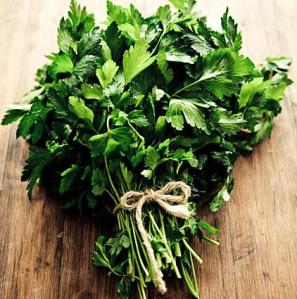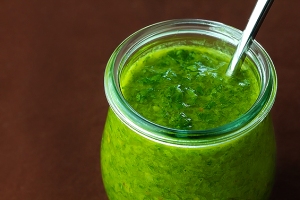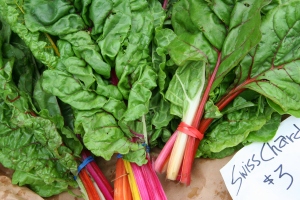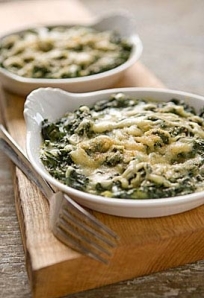 PARSLEY: Parsley is an excellent source of vitamin K and vitamin C as well as a good source of vitamin A, folate, and iron. Parsley is also good for digestion. As with other bitter herbs, parsley stimulates appetite and your digestive tract. Parsley keeps your immune system strong, tones your bones and heals the nervous system, too. It helps flush out excess fluid from the body, thus supporting kidney function. However, the herb contains oxalates, which can cause problems for those with existing kidney and gall bladder problems. Regular use of parsley can help control your blood pressure. The folic acid in this herb is like a tonic for your heart. Use parsley daily, and you’ll feel relief from joint pain, that’s because the herb has anti-inflammatory properties. Parsley tea relaxes stiff muscles and encourages digestion. Parsley tea proved useful in the trenches (WWI), when our men got kidney complications. Parsley was reputed to have sprung from the blood of the Greek heroArchemorus, the forerunner of death. There is an old superstition against transplanting parsley plants. The herb is said to be dedicated to Persephone and to funeral rites by the Greeks.
PARSLEY: Parsley is an excellent source of vitamin K and vitamin C as well as a good source of vitamin A, folate, and iron. Parsley is also good for digestion. As with other bitter herbs, parsley stimulates appetite and your digestive tract. Parsley keeps your immune system strong, tones your bones and heals the nervous system, too. It helps flush out excess fluid from the body, thus supporting kidney function. However, the herb contains oxalates, which can cause problems for those with existing kidney and gall bladder problems. Regular use of parsley can help control your blood pressure. The folic acid in this herb is like a tonic for your heart. Use parsley daily, and you’ll feel relief from joint pain, that’s because the herb has anti-inflammatory properties. Parsley tea relaxes stiff muscles and encourages digestion. Parsley tea proved useful in the trenches (WWI), when our men got kidney complications. Parsley was reputed to have sprung from the blood of the Greek heroArchemorus, the forerunner of death. There is an old superstition against transplanting parsley plants. The herb is said to be dedicated to Persephone and to funeral rites by the Greeks.
PREP TIME: Fresh parsley should be washed right before using since it is highly fragile. The best way to clean it is just like you would spinach. Place it in a bowl of cold water and swish it around with your hands. This will allow any sand or dirt to dislodge. Remove the leaves from the water, empty the bowl, refill it with clean water and repeat this process until no dirt remains in the water. Fresh parsley should be kept in the refrigerator in a plastic bag. If the parsley is slightly wilted, either sprinkle it lightly with some water or wash it without completely drying it before storing in the refrigerator.
PARSLEY RECIPES: Parsley is so much more than a garnish on your plate.
CHIMICHURRI SAUCE
{courtesy of Gimme Some Oven}
1 cup fresh (flat-leaf) parsley leaves, tightly packed
2 Tbsp. fresh oregano leaves, tightly packed
3 cloves of garlic
2 Tbsp. red wine vinegar
¼ tsp sea salt
¼ tsp freshly-ground black pepper
½ tsp red pepper flakes
½ cup good-quality olive oil
Place all ingredients in food processor except for the olive oil. Pulse until finely chopped. Transfer to a jar or bowl, and whisk in olive oil until combined. Use immediately or refrigerate for up to one week.
**Pairs well with steak, chicken fish or seafood.
SAFFRON CHICKEN WITH PARSLEY AND LEMON
{courtesy of Kalyn’s Kitchen}
2 boneless, skinless chicken breasts
1 large or 2 small onions, cut in lengthwise slivers (this is a little more onions than original recipe)1 T olive oil
1 tsp. butter (optional, but it adds a lot of flavor)
pinch saffron (about 1/4 tsp. or less)
3/4 cup chicken stock (this is a little more chicken stock than original recipe)
1 1/2 T fresh lemon juice (this is a little more lemon than original recipe)
1/4 cup finely chopped fresh parsley
Trim all visible fat and tendons from chicken breasts and cut in 1/2 strips on the diagonal to make small cutlets. Peel the onions and cut into lengthwise slivers and chop parsley. Use a heavy frying pan which is not too large and has a tight-fitting lid. Heat the olive oil and butter, then brown the chicken quickly over medium-high heat. (Don’t let it cook long enough that the outside starts to get hard. The chicken does not need to be cooked through.) Remove chicken to a plate, add onion, and brown over very low heat until edges of onion pieces are turning golden, about 12-15 minutes. Remove browned onions to another plate. Add chicken back to pan, and cover with onions. Heat chicken stock, add saffron and stir to dissolve, then pour over chicken and onions. Simmer on very low heat with pan covered 30-45 minutes. Add chopped parsley, lemon juice, and a tiny bit of additional water if needed, and simmer 15 minutes more. Serve hot, over rice if desired.
MORE PARSLEY RECIPES: Parsley, Kale and Berry Smoothie, Buttery Lemon Parsley Noodles, Parsley Pinenut Pesto, Parsley Soup, Roasted Carrots with Parsley Butter
 SWISS CHARD: First of all the name Swiss Chard is a little misleading. The botanist who discovered and then named it hailed from Switzerland; however, its origin is farther south, in the Mediterranean region, specifically Sicily. This tall leafy vegetable is a part of the goosefoot family — aptly named because the leaves resemble a goose’s foot. Other members are beets and spinach. It goes by several other names including silverbeet, Roman kale, and strawberry spinach.
SWISS CHARD: First of all the name Swiss Chard is a little misleading. The botanist who discovered and then named it hailed from Switzerland; however, its origin is farther south, in the Mediterranean region, specifically Sicily. This tall leafy vegetable is a part of the goosefoot family — aptly named because the leaves resemble a goose’s foot. Other members are beets and spinach. It goes by several other names including silverbeet, Roman kale, and strawberry spinach.
Chard is a great source of vitamin K, A and C, and is a wonderful cauldron of potassium, magnesium, iron and fiber. It is high in antioxidants, making it (once again) another great super food. AND it’s low in calories. A single serving is merely 35 calories, yet contains more than 300% of your daily vitamin K needs and more than a third of your daily value of vitamin C. Swiss chard also offers fantastic antioxidant protection in the form of phytonutrients known as carotenoids. Specifically, the beta-carotene, lutein, and zeaxanthin found in chard help maintain eye health and may reduce the risk of cataracts. Aside from supporting your eyes and immune system, chard helps maintain bones and may protect against osteoporosis, thanks to the high doses of vitamin K and magnesium as well as a good amount of calcium. And to top it off it is also rich in a multitude of B-complex vitamins (especially good for vegetarians).
A note though…Swiss chard contains oxalic acid, a naturally-occurring substance found in some vegetables, which may crystallize as oxalate stones in the urinary tract in some people. So it is advisable to avoid eating chard in people with known kidney stones.
PREP TIME: Chard is an extremely perishable leafy vegetable, so it should be used as early as possible once harvested. As I always say with greens, rinse thoroughly in cool water and pat dry. Fold each leaf in half lengthwise; cut out hard vein. This part can be eaten as well, but you may want to chop it up and start it a bit ahead of time, to cook evenly with the leafy parts. To easily chop Swiss Chard roll up the leaf lengthwise and slice across into strips. You can usually store Swiss Chard in the refrigerator for 1-2 days.
RECIPES: Swiss chard has an earthy salty, yet bitter taste. Mature leaves and stalks are typically cooked, braised or sautéed; the bitter flavor fades with cooking. However, antioxidant properties of chard are significantly decreased on steaming, frying and boiling. Try Swiss chard in smoothies, frittatas, as a side or in soups.
Swiss Chard Gratin
{courtesy of Whole Foods Market}
2 bunches Swiss chard leaves, chopped (about 8 cups packed)
1 cup water
1 tablespoon extra virgin olive oil
1 tablespoon unsalted butter, more for the baking dish
1 cup low-fat milk
2 tablespoons unbleached white flour
Sea salt and freshly ground black pepper
1/4 cup grated Parmesan cheese, divided
1 tablespoon whole wheat bread crumbs
Preheat oven to 350°F. Place chard leaves in a saucepan with the water and cook over medium heat until leaves are just tender, 3 to 4 minutes. Drain, reserving 1/4 cup of the cooking liquid. Set chard aside. In the same saucepan, heat olive oil and butter over medium heat. When butter has melted, whisk in the flour until blended. Whisk constantly for 1 minute. Slowly whisk in the milk and reserved cooking liquid. Continue cooking and stirring until the sauce thickens, 3 to 5 minutes. Season with salt and pepper and stir in half of the grated cheese. Stir in the cooked chard and transfer to a buttered 9×9-inch baking dish. Sprinkle with remaining cheese and breadcrumbs. Bake for 20 minutes or until hot and bubbling.
Swiss Chard and Ricotta Pizza
{courtesy of Real Simple}
1/4 cup olive oil, plus more for serving
1 pound pizza dough, at room temperature
kosher salt and black pepper
2 bunches Swiss chard, thick stems removed and sliced and leaves chopped
2 cloves garlic, chopped
1 teaspoon red wine vinegar
1 cup ricotta
Heat oven to 450° F. Rub the bottom of a rimmed baking sheet with 2 tablespoons of the oil. Press the dough into a 10-by-12-inch rectangle on the prepared baking sheet. Season with ¼ teaspoon each salt and pepper. Bake until golden brown, 18 to 22 minutes. Meanwhile, heat the remaining 2 tablespoons of oil in a large skillet over medium-high heat. Add the chard stems and ¼ teaspoon each salt and pepper and cook, stirring occasionally, until tender, 4 to 6 minutes. Add the chard leaves, garlic, and ¼ teaspoon each salt and pepper and cook, stirring occasionally, until tender, 2 to 4 minutes. Stir in the vinegar. Dollop the ricotta on the pizza and top with the chard mixture. Drizzle with olive oil.
MORE RECIPES: Cream-Braised Chicken With Swiss Chard and Potatoes, Light Swiss Chard Frittata, Garlicky Swiss Chard and Chickpeas, Sausage and Swiss Chard Strata, Swiss Chard, Garlic and Gruyère Pizza, Baked Potatoes With Ricotta, Swiss Chard and Toasted Garlic